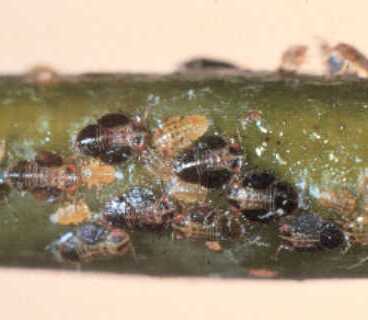|
Pear Psylla
View more pictures: Bing Images Google Images Yahoo Images Common names: Pear Psylla Scientific name: Psylla pyricola Region: This insect can be found in eastern United States and the Pacific Northwest, with similar species found elsewhere. Life cycle: The Pear Psylla insect produces three to five generations each year and hibernates under the edges of rough bark on the trunk and branches, or in garden rubbish, and emerge during the first warm days in April. Soon after, they deposit their eggs. A month is all that is needed to complete its life cycle. Physical description: This 1/10 inch long psylla is reddish brown to dark orange with green or red markings and transparent wings. They resemble a miniature Cicada. The eggs are yellow and are laid in old leaf scars, in cracks and crevices, and around the base of buds. The nymphs are small and yellow. Feeding characteristics: This pest attacks pear, quince, potato, and tomato plants. The nymphs feed on the top of leaves leaving only the veins. They go to the axils of leaf petioles and begin to suck sap. They excrete honeydew, which drips onto the lower leaves and encourages the growth of a sooty mold. Many leaves develop brown spots and fall before the fruit is ripe, and buds may fail. The fruit can also become scarred. The piercing mouthparts also transmit the mycroplasma organism responsible for pear decline in western states. Controls: Apply a 2 percent solution of dormant oil in the spring just as the buds begin to swell. This will kill the overwintering psylla as they begin to lay their eggs. If they are well established, dust with limestone or Diatomaceous earth. The Chalcid Wasp parasitizes the psylla nymphs and one wasp can eliminate up to 90 percent of the nymphs in July and August. Pirate bugs, lacewing larvae, snakefly larvae and adults, and the larvae of Lady Beetles are also valuable predators and can reduce psylla numbers to an insignificant amount. Return from Pear Psylla to Insects M-P Encyclopedia of Garden Insects |
